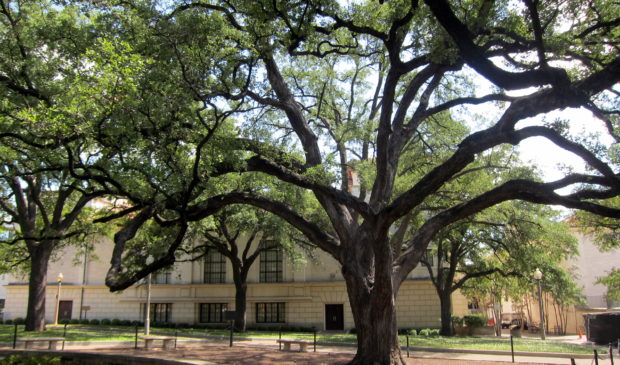Environmental Commission discusses how to make the Heritage Tree Ordinance even more tree-centric
Friday, September 6, 2019 by
Jessi Devenyns Austin values its trees. According to the city arborist’s office, trees are a $16 billion asset to the community.
In 1982, in an effort to better protect its trees, Austin implemented its inaugural tree ordinance, which was unique both then and now for its preservation-first approach. Since then, the city has evolved, and so have its tree protections.
The latest iteration of local government protection for trees is known as the Heritage Tree Ordinance, which is “one of the most progressive tree regulations in this country,” Keith Mars, the Community Tree Preservation Division manager, told the Environmental Commission at its Aug. 21 meeting.
The Heritage Tree Ordinance protects all trees with trunks that are at least eight inches in diameter. Trees with trunks 19 inches or greater require a permit for removal and trees larger than 24 inches require a variance for removal.
Other communities in the U.S. offer developers the option to preserve or replant, but here in River City, citizens hold preservation above all else. Mars said that city staffers have reviewed over 5,000 cases and saved 95 percent of the trees that were slated for removal since City Council passed the ordinance in 2010.
In that time, the Environmental Commission has seen only a handful of tree removal requests come before them. “You don’t see many, but when you do, they’re important, they’re impactful,” explained Mars.
Lauren Ice, an attorney and East Austin resident, came before the commission to say that perhaps the percentage of cases reviewed should be greater. She pointed to a heritage tree at 1204 San Antonio St. that was taken down with an administrative approval earlier this year.
Removal of a heritage tree can be granted if a tree inhibits reasonable use of or access to a property or is determined to be dead, diseased or an imminent hazard. The tree on San Antonio Street was deemed to be an imminent hazard due to storm damage that tore off a major limb and exposed interior rot in the trunk.
Ice said that the “imminent hazard” determination was made seven months after the storm damaged the tree and “there is not a record of the decision existing prior to the tree being removed,” she said.
Mars agreed that the paper trail was convoluted, but provided the Austin Monitor with a timeline of events that confirmed the tree was deemed a hazard in October 2018 but not permitted for removal until May of this year. The storm event that altered the status of the tree occurred six months after city arborists consulted with the property developer on how best to preserve the tree.
Nevertheless, Chair Linda Guerrero called the decision process on the removal “embarrassing.”
“When you do look at the (paper) trail, it’s not good,” she said.
Looking at Austin’s urban canopy through a wider lens, the commissioners expressed their dismay at the loss of any heritage tree. “We’re losing trees here in Austin,” said Commissioner Mary Ann Neely. She cited a variety of reasons for this phenomenon, including increased development and rising temperatures.
Development, in particular, poses a problem for old-growth trees. Even well-established trees are not always hardy enough to survive construction. In those cases, Mars said that the city arborist will grant a variance for their removal and the developer is required to mitigate the loss of the tree.
Mitigation for heritage trees is 300 percent of the diameter of the tree. That means for a 30-inch tree, mitigation would be 90 inches, and every inch costs the developer $200.
Despite the risks, Commissioner Peggy Maceo said, “I think we should always give the tree a chance. … They can make some incredible comebacks.”
Mars pointed out that nothing in the code requires developers to provide a certain level of tree maintenance. Therefore, it is a risk to leave a heritage tree standing that is unlikely to survive construction. If the tree doesn’t make it, the city has no recourse to recoup the lost canopy. Whereas if the tree is removed, the developers mitigate with new plantings.
For some commissioners, though, that guarantee of new canopy to the urban forest was not enough.
“To me, we need them to replace that percentage of canopy that was taken. Not three little trees,” Guerrero said.
While Mars did not have an answer on the dais, he did agree that he would like to see an improved option for mitigation.
Commissioner Curtis Smith was absent from the discussion.
Photo by Wally Gobetz made available through a Creative Commons license.
The Austin Monitor’s work is made possible by donations from the community. Though our reporting covers donors from time to time, we are careful to keep business and editorial efforts separate while maintaining transparency. A complete list of donors is available here, and our code of ethics is explained here.
You're a community leader
And we’re honored you look to us for serious, in-depth news. You know a strong community needs local and dedicated watchdog reporting. We’re here for you and that won’t change. Now will you take the powerful next step and support our nonprofit news organization?








